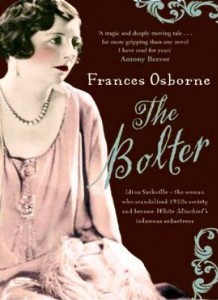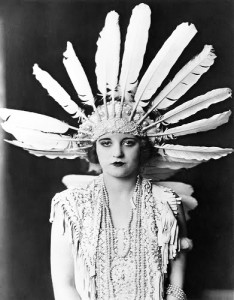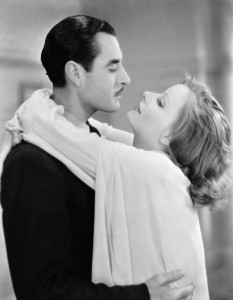“In an age of wicked women, [Idina Sackville] had pushed the boundaries of behavior to extremes.…She danced, stayed out all night, and slept around more noticeably than her fellows. When the sexual scandals of Happy Valley gripped the world’s press, Idina was at the heart of them. When women were…divorcing to marry again, Idina did so – not just once, but several times. As one of her many in-laws told me, ‘It was an age of bolters, but Idina was by far the most celebrated.’ ”
 Using documents and photographs that have never before been available, along with private diaries and interviews with some of those who knew Idina Sackville, author Frances Osborne creates a lively, readable, and well researched biography which attempts to understand what aspects of Idina Sackville’s early family life might have helped create a person so flamboyant, sexually adventurous, and hedonistic that she became world famous, just for being who she was. The author has special reason to ponder this subject. When she was thirteen, The Sunday Times (London) began a serialization of James Fox’s White Mischief, a detailed account of Happy Valley and the British aristocrats who had participated in the “mischief” in Kenya. The author and her twelve-year-old sister Kate devoured each installment as it came out. “Was this the secret to being irresistible to men,” she wondered, “to behave as this woman did, while ‘walking barefoot at every available opportunity’ as well as being ‘intelligent, well-read, enlivening company’?” One afternoon, with a twinkle in his eye, her father told his embarrassed wife Davina that it was time for her to come clean. Davina had to admit to her daughters that she was the granddaughter of Idina Sackville, and they themselves were Idina’s great-granddaughters.
Using documents and photographs that have never before been available, along with private diaries and interviews with some of those who knew Idina Sackville, author Frances Osborne creates a lively, readable, and well researched biography which attempts to understand what aspects of Idina Sackville’s early family life might have helped create a person so flamboyant, sexually adventurous, and hedonistic that she became world famous, just for being who she was. The author has special reason to ponder this subject. When she was thirteen, The Sunday Times (London) began a serialization of James Fox’s White Mischief, a detailed account of Happy Valley and the British aristocrats who had participated in the “mischief” in Kenya. The author and her twelve-year-old sister Kate devoured each installment as it came out. “Was this the secret to being irresistible to men,” she wondered, “to behave as this woman did, while ‘walking barefoot at every available opportunity’ as well as being ‘intelligent, well-read, enlivening company’?” One afternoon, with a twinkle in his eye, her father told his embarrassed wife Davina that it was time for her to come clean. Davina had to admit to her daughters that she was the granddaughter of Idina Sackville, and they themselves were Idina’s great-granddaughters.

Immediately, Frances Osborne could “feel my great-grandmother’s long, manicured fingernails resting on my forearm as I wondered which of her impulses might surface in me.” For over thirty years, Idina Sackville had done exactly what she wanted, when she wanted, and with whom she wanted, becoming famous on three continents for her outrageous sexual exploits, her nudity at parties, the bed-hopping games she invented for house parties, her drinking, and even her occasional experimentation with drugs. Her friends, especially in Kenya’s Happy Valley, equally amoral, participated in several shootings or attempted shootings, the highly publicized murder of one of Idina’s ex-husbands, the subsequent trial for that murder involving another member of Happy Valley, several suicides, and cases of drug addiction, one of them leading to death.

1923 Hispano Suiza, the car Idina brought to Kenya
Beginning with Idina’s earliest background, the author explores the family history. Idina’s father, Gilbert Sackville, the 8th Earl of De La Warr, possessed an eight hundred-year-old title but very little income. Her mother, Muriel Brassey, on the other hand, was the non-aristocratic granddaughter of a man who had been so successful in “trade” that on his death he left “the largest amount for which probate has ever been granted under any one will.” Their marriage in 1891, pointedly not attended by his parents, made her a countess and gave him an income beyond what he could ever have imagined. They quickly had two daughters, Idina and Avie, and then a son who became the 9th Earl. Then, in 1902, as if to prove that her husband’s parents were right in disapproving of their aristocratic son’s marriage, Muriel shocked society by suing for divorce, almost unheard of, thereby preventing Gilbert from spending any more of her money on mistresses, most recently a cancan dancer, and giving her an opportunity to become independent. She soon built a house for her children, only a few miles away from the house they’d shared, and at least as elegant. Hers, unlike her ex-husband’s, was paid for.

The young Tallulah Bankhead, an Idina protegee
The mores of the times, in which many marriages were marriages of convenience, allowed both husbands and wives to take lovers, often from among their married friends. Married lovers, unlike lovers who were single, did not expect a change in their lover’s status quo, thereby preserving the lover’s family assets – and if a pregnancy resulted, the child could be incorporated into the woman’s already existing family. King Edward VII had set the pattern, with many lovers from among his friends’ wives, and adultery became “one of the ways in which those who did not have to work for a living could fill their afternoons.” As actress Mrs. Patrick Campbell said, “It doesn’t matter what you do in the bedroom as long as you don’t do it in the street and frighten the horses.” Muriel Brassey’s decision to divorce, an obvious breach of established social behavior, and her involvement in socialist causes and the suffrage movement further alienated her from aristocratic society and tainted the futures of her children. Eventually, however, Idina met a young Cavalry officer, David Euan Wallace, as much of a party animal as she was, whom she married and with whom she planned a sumptuous country house “with five wings and sixty-five rooms on the ground and first floors alone.”

Greta Garbo, playing the role of Idina, with John Gilbert, in A Woman of Affairs
Before long, however, Euan was flagrantly unfaithful, and when World War I intervened and he was in France for much of the time, their bond frayed, despite their two small sons. Eventually, she divorced him to escape to Kenya with someone else, forced to leave the boys, aged four and three, behind, though she indicated to her dying day that she had always loved Euan. Eventually, she would have four more marriages and divorces and would become the “undisputed Queen of Happy Valley” in Kenya, her bed referred to as “the battleground.” Michael Arlen wrote a novel entitled The Green Hat about her, and its film version, A Woman of Affairs starred Greta Garbo. Nancy Mitford wrote three novels in which “the bolter,” the main character was purportedly modeled on Idina. Idina’s five marriages each lasted between four and eight years, but after each one, she “bolted” for someone or someplace new.

The remains of “Clouds,” the house Idina built during her fourth marriage.
A fascinating sociological study of the mores of aristocratic England and a personal study of Idina Sackville, who was both its victim and its most celebrated example, The Bolter will fascinate those interested in this period and in the unstated rules of aristocratic “society.” Most readers will become so involved in the story that they will probably ignore the sometimes awkward descriptions, the simple conclusions, and the possibly incorrect motivations attributed to the characters. The fact that many of these attitudes toward marriage, divorce, and the taking of lovers continues among the British high aristocracy after all these years continues to prove that old habits die slowly indeed.
Photos, in order: The author’s photo appears on http://www.standard.co.uk
Idina purchased a 1923 Hispano Suiza car with a stork hood ornament, like this one, and took it with her to the mountains of Kenya. http://www.todaysvintage.com
After her first divorce, Idina moved in with a friend, Olga Lynn (Oggie), a singer and swinger in London. When Tallulah Bankhead, a 21-year-old American (shown here with feathered headdress), came to London to appear in the show Dancers, they took her in and showed her how to diet off her puppy fat, then taught her about food and wine and “how to be decadent with style.” http://home.hiwaay.net
Greta Garbo, with John Gilbert, playing the role of Idina in A Woman of Affairs, based on the book, The Green Hat, by Michael Arlen. http://www.doctormacro.com
 The remains of the house “Clouds,” which Idina built during her fourth marriage (to Donald Haldeman), now belongs to a multi-generational Kikuyu family with different family groups living separately in the various wings. http://www.cuboimages.it
The remains of the house “Clouds,” which Idina built during her fourth marriage (to Donald Haldeman), now belongs to a multi-generational Kikuyu family with different family groups living separately in the various wings. http://www.cuboimages.it
The former living room and dining room at Clouds are now used only for storing maize: http://afarmhouseinkenya.com
